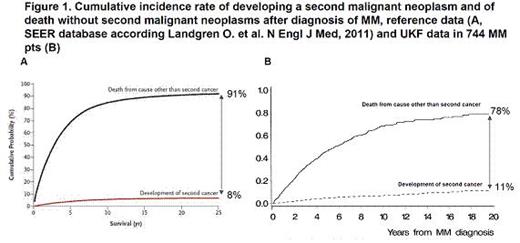Abstract
Second malignant neoplasms after first-line therapy and maintenance-therapy have been reported in clinical studies; however, no risk factors have been established. Moreover, second malignant neoplasms is gaining increasingly more attention as multiple myeloma patients live longer and data from randomized studies suggest there are associations between certain newer drugs and the risk of developing second malignant neoplasms. Clinical trials are not statically powered to define risk factors for second malignant neoplasms.
We have conducted a large study designed to define the rate of second malignant neoplasms in a well-characterized clinical multiple myeloma cohort. We identified 744 consecutive patients treated at our institution between 1997-2011 and analyzed 1. onset of second malignant neoplasms, 2. patient characteristics (age, gender, familiar risks, smoking status, immune status), 3. frequency of different neoplasms, 4. potential multiple myeloma specific risk factors and 5. possible treatment-related risk factors (novel agents, autologous stem cell transplantation [single vs. tandem (t)-ASCT], allogeneic (allo-) SCT, frequency of alkylating agents, cycles/lines of therapy and ionizing radiation).
118 (16%) multiple myeloma patients developed second malignant neoplasms. Prior or synchronous malignant neoplasms were observed in 83 patients (63%) and second malignant neoplasms developed subsequent to multiple myeloma in 49 (37%) patients. Overall, most (77%) of these neoplasms were solid tumors; whereas hematological neoplasms with 23% were prominently observed subsequent to multiple myeloma. Furthermore, multiple myeloma who developed second malignant neoplasms (versus those who did not) were older, predominantly male, had IgG-MM and more CTx-cycles, use of steroids, alkylators, lenalidomide/thalidomide and radiotherapy, but lacked laboratory abnormalities nor did they have more ASCTs or bortezomib therapy. The risk of dying of multiple myeloma due to disease progression remained substantially higher than that of developing a second malignant neoplasm (cumulative incidence at 20 years: 78% vs. 11%, respectively). However, since multiple myeloma prognosis increases and death at 20 years of follow-up decreases, the development of second malignant neoplasms remains highly relevant (Figure 1; comparison of the SEER database with our UKF data).
Matching the SEER database with our data (Figure 1) confirms the rate of second malignant neoplasms at 20 years of follow-up at around 10%, whereas death from other causes (multiple myeloma) seems to substantially decrease. Further comparison is currently under way and will expand our knowledge on the development of second malignant neoplasms. Our prior (Hasskarl J.,..Engelhardt M. 2011) and previous analyses suggest that physicians need to discuss individual risk-benefit ratios with patients and stay updated as more knowledge becomes available on this topic. It is likely that second malignant neoplasms in multiple myeloma patients remain important given that the prognosis in multiple myeloma has substantially increased and patients live significantly longer.
Kleber:Celgene: Educational grant Other. Engelhardt:Celgene: Educational grant Other.
Author notes
Asterisk with author names denotes non-ASH members.


This feature is available to Subscribers Only
Sign In or Create an Account Close Modal